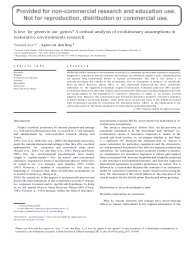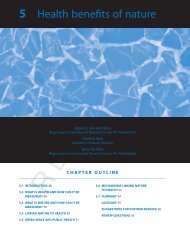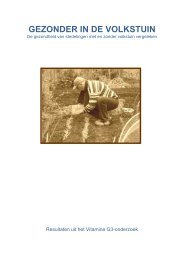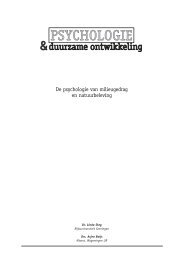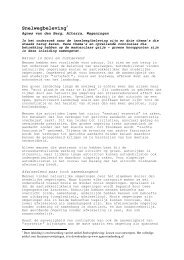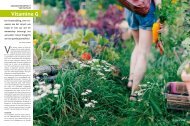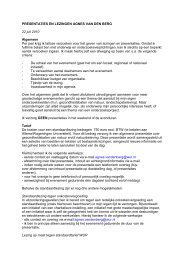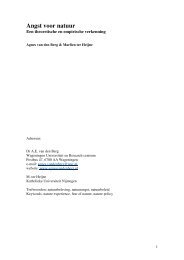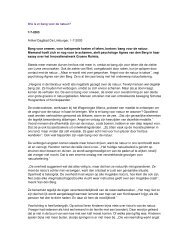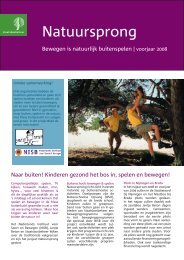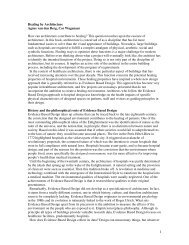New wilderness in the Netherlands - Agnes van den Berg
New wilderness in the Netherlands - Agnes van den Berg
New wilderness in the Netherlands - Agnes van den Berg
You also want an ePaper? Increase the reach of your titles
YUMPU automatically turns print PDFs into web optimized ePapers that Google loves.
368 A.E. Van <strong>den</strong> <strong>Berg</strong>, S.L. Koole / Landscape and Urban Plann<strong>in</strong>g 78 (2006) 362–372Table 1Mean rat<strong>in</strong>gs of <strong>wilderness</strong> (scale range 1–5) and beauty (scale range 1–6) formanaged and wild nature development landscapes <strong>in</strong> six areas (N = 500, standarddeviations <strong>in</strong> paren<strong>the</strong>ses)Area Perceived <strong>wilderness</strong> (1–5) Perceived beauty (1–6)Managed Wild Managed Wild1 2.05 (.83) 4.14 (.78) 3.87 (.76) 4.69 (.88)2 2.37 (.98) 3.75 (.94) 3.49 (1.01) 4.14 (1.00)3 2.63 (.88) 3.84 (.92) 3.88 (.79) 4.25 (1.09)4 2.73 (.95) 4.18 (.85) 4.25 (.89) 3.73 (1.15)5 3.00 (.91) 4.16 (.79) 4.32 (.84) 4.75 (.86)6 2.05 (.81) 4.01 (.85) 3.71 (.91) 4.29 (1.08)Total 2.48 (.56) 4.01 (.58) 3.92 (.55) 4.31 (.69)Note. See Fig. 1 for depictions of <strong>the</strong> landscapes; perceived <strong>wilderness</strong> was measuredby ask<strong>in</strong>g respon<strong>den</strong>ts to rate <strong>the</strong> applicability of <strong>the</strong> description: ‘a wildlandscape where nature can take its own course’. All means differ significantlybetween wild and cultivated landscapes at p < .001.tions <strong>in</strong> perceived <strong>wilderness</strong> of <strong>the</strong> landscapes. To exam<strong>in</strong>e<strong>the</strong> <strong>in</strong>fluence of cont<strong>in</strong>uous variations <strong>in</strong> perceived <strong>wilderness</strong>on landscape preferences, we re-analyzed <strong>the</strong> data us<strong>in</strong>g multilevelanalysis (Bryk and Rau<strong>den</strong>bush, 1992; see Van <strong>den</strong> <strong>Berg</strong>et al., 1998, for an application <strong>in</strong> <strong>the</strong> doma<strong>in</strong> of nature evaluation).We formulated a basic two-level model, with <strong>in</strong>dividualbeauty rat<strong>in</strong>gs of <strong>the</strong> twelve landscapes as lower level observationsnested with<strong>in</strong> persons. Effects of perceived <strong>wilderness</strong>on beauty rat<strong>in</strong>gs, and socio-economic differences <strong>in</strong> relationsbetween <strong>wilderness</strong> and beauty, were estimated by add<strong>in</strong>g rat<strong>in</strong>gsof perceived <strong>wilderness</strong>, socio-economic variables, recreationalmotives, and <strong>the</strong>ir <strong>in</strong>teraction terms to this model. Theresults of <strong>the</strong> multilevel analysis were highly similar to thoseproduced by <strong>the</strong> l<strong>in</strong>ear regression analysis with <strong>the</strong> preference<strong>in</strong>dex as a s<strong>in</strong>gle depen<strong>den</strong>t variable (see Van <strong>den</strong> <strong>Berg</strong> (1999,Chapter 5) for a more detailed description of <strong>the</strong> outcomesof <strong>the</strong> multilevel analysis). Because <strong>the</strong> regression approachis more conventional and easier to <strong>in</strong>terpret for most readersthan multilevel analysis, we rema<strong>in</strong>ed with this approach <strong>in</strong> thisarticle.3. Results3.1. Perceived <strong>wilderness</strong>To check whe<strong>the</strong>r our classification of <strong>the</strong> landscapes as‘wild’ versus ‘managed’ corresponded to respon<strong>den</strong>ts’ perceptions,we compared respon<strong>den</strong>ts’ average <strong>wilderness</strong> rat<strong>in</strong>gs ofwild landscapes to <strong>the</strong>ir average <strong>wilderness</strong> rat<strong>in</strong>gs of managedlandscapes. Rele<strong>van</strong>t means are displayed <strong>in</strong> <strong>the</strong> left half ofTable 1. Wild landscapes were generally perceived as wilderand more spontaneous <strong>in</strong> character than <strong>the</strong>ir managed counterparts,M = 4.01 versus M = 2.47, t(499) = 47.20, p < .001. Thisdifference <strong>in</strong> perceived <strong>wilderness</strong> was found for each pair oflandscapes, all p’s < .001. Thus, respon<strong>den</strong>ts’ perceptions of <strong>the</strong>landscapes as wild or managed corresponded with variations <strong>in</strong>nature management strategies between <strong>the</strong> landscapes.Table 2Mean beauty rat<strong>in</strong>gs (scale range 1–6) for managed and wild nature developmentlandscapes <strong>in</strong> six areas rated by resi<strong>den</strong>ts and nonresi<strong>den</strong>ts (standard deviations<strong>in</strong> paren<strong>the</strong>ses)Area Resi<strong>den</strong>ts Nonresi<strong>den</strong>tsManaged Wild Managed Wild1 4.00 a (.85) 4.84 b (.77) 3.85 a (.75) 4.66 b (.91)2 4.13 a (1.07) 4.11 a (1.26) 3.36 b (.95) 4.15 a (.95)3 3.80 a (.85) 4.28 b (1.17) 3.89 a (.78) 4.25 b (1.08)4 4.29 a (1.06) 3.73 b (1.23) 4.24 a (.86) 3.72 b (1.13)5 4.56 a (.83) 4.81 b (1.00) 4.29 c (.84) 4.75 a,b (.83)6 4.00 a (.95) 4.55 b (1.06) 3.65 c (.89) 4.23 d (1.08)Note. Means with unequal letters differ per row at p < .05.3.2. Perceived beautyRespon<strong>den</strong>ts generally perceived both <strong>the</strong> wild and managedlandscapes as beautiful. As can be seen <strong>in</strong> <strong>the</strong> right halfof Table 1, mean beauty rat<strong>in</strong>gs of both types of landscapeswere well above <strong>the</strong> conceptual midpo<strong>in</strong>t of <strong>the</strong> scale, whichwas already positively skewed. The ANOVA also revealed asignificant effect of landscape type, which <strong>in</strong>dicated that wildlandscapes were generally perceived as more beautiful thanmanaged landscapes, M = 3.92 versus M = 4.31, t(499) = 9.92,p < .001. Higher beauty rat<strong>in</strong>gs for wild landscapes were foundfor five out of <strong>the</strong> six landscape pairs, all p’s < .001. Theonly exception to this pattern was obta<strong>in</strong>ed for <strong>the</strong> pair oflandscapes from Area 4 (a forested area). In Area 4, <strong>the</strong>wild landscape was rated significantly less beautiful than <strong>the</strong>managed landscape, M = 3.73 versus M = 4.25, t(499) = 7.88,p < .001.3.3. Resi<strong>den</strong>ts versus nonresi<strong>den</strong>tsTable 2 provides an overview of mean beauty rat<strong>in</strong>gs by resi<strong>den</strong>tsand nonresi<strong>den</strong>ts. In Areas 2, 5 and 6, resi<strong>den</strong>ts rated <strong>the</strong>managed plan for <strong>the</strong>ir own area as significantly more beautifulthan nonresi<strong>den</strong>ts, all p’s < .01. In addition, resi<strong>den</strong>ts of Area6 also rated <strong>the</strong> wild landscape <strong>in</strong> <strong>the</strong>ir own area significantlymore beautiful than nonresi<strong>den</strong>ts, p < .05.The strongest differences <strong>in</strong> landscape preferences betweenresi<strong>den</strong>ts and nonresi<strong>den</strong>ts were found <strong>in</strong> Area 2. As can be seen<strong>in</strong> Table 1, nonresi<strong>den</strong>ts rated <strong>the</strong> managed landscape <strong>in</strong> Area 2as significantly less beautiful than <strong>the</strong> wild landscape, M = 3.36versus M = 4.15, while resi<strong>den</strong>ts of Area 2 rated <strong>the</strong> managedlandscape <strong>in</strong> <strong>the</strong>ir area as slightly more beautiful than <strong>the</strong> wildlandscape, M = 4.13 versus M = 4.11. This <strong>in</strong>teraction-effect washighly significant, F(1,499) = 29.03, p < .001.We analyzed beauty rat<strong>in</strong>gs of resi<strong>den</strong>ts of Area 2 <strong>in</strong> moredetail to f<strong>in</strong>d out whe<strong>the</strong>r <strong>the</strong>ir higher preference for managednature applied only to <strong>the</strong>ir own area, or whe<strong>the</strong>r it also appliedto landscapes from <strong>the</strong> o<strong>the</strong>r five areas. Results of this analysisshowed that resi<strong>den</strong>ts from Area 2 also rated <strong>the</strong> managedlandscape <strong>in</strong> three o<strong>the</strong>r areas significantly more beautiful thano<strong>the</strong>r nonresi<strong>den</strong>ts of <strong>the</strong>se areas, all p’s < .05. This f<strong>in</strong>d<strong>in</strong>g suggeststhat <strong>the</strong> higher preference for managed nature by resi<strong>den</strong>tsof Area 2 reflects a general preference for managed landscapes,



